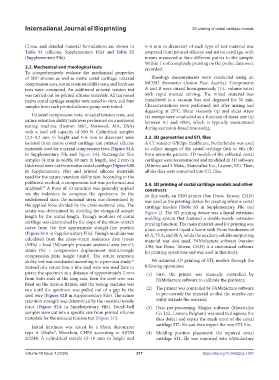Page 225 - IJB-10-1
P. 225
International Journal of Bioprinting 3D printing of costal cartilage models
China, and detailed material formulations are shown in 5–6 mm in diameter) of each type of test material was
Table S1 (silicone, Supplementary File) and Table S2 prepared from printed silicone and native cartilage, with
(Supplementary File). means measured at four different points in the sample.
Within 1 s of completely pressing on the probe, data were
2.2. Mechanical and rheological tests recorded.
To comprehensively evaluate the mechanical properties
of 3DP silicone as well as native costal cartilage, uniaxial Rheology measurements were conducted using an
compression tests, suture retention ability tests, and hardness MCR92 rheometer (Anton Paar, Austria). Components
tests were conducted. An additional uniaxial tension test A and B were mixed homogeneously (1:1, volume ratio)
was carried out for printed silicone materials. All harvested with rapid manual stirring. The mixed material was
native costal cartilage samples were tested in vitro, and four transferred to a vacuum box and degassed for 30 min.
samples from each printed silicone group were tested. Characterizations were performed just after mixing and
degassing at 25°C. Shear viscosity (η) and shear stress
Uniaxial compression tests, uniaxial tension tests, and (τ) sweeps were conducted as a function of shear rate (γ)
suture retention ability tests were performed on a universal between 0.1 and 100/s, which is typically encountered
testing machine (Instron 5967, Norwood, MA, USA) during extrusion-based processing.
with a load cell capacity of 500 N. Cylindrical samples
(2.2–9.2 mm in height and 5–6 mm in diameter) were 2.3. 3D geometries and STL files
isolated from native costal cartilage and printed silicone A CT scanner (Philips Healthcare, Netherlands) was used
materials used for uniaxial compression tests (Figure S1A to collect images of the costal cartilage (6th to 8th rib)
in Supplementary File and Figure 3A). Rectangular film from microtia patients. 3D models of the collected costal
samples (4 mm in width, 40 mm in length, and 2 mm in cartilages were reconstructed and modified in 3D software
thickness) were cut from native costal cartilage (Figure S2B (Mimics and 3-Matic, Materialise Inc., Leuven, BE). Then,
in Supplementary File) and printed silicone materials all the data were converted into STL files.
used for the suture retention ability test. According to the
published method, a compression test was performed and 2.4. 3D printing of costal cartilage models and other
analyzed. A force of 10 mm/min was generally applied constructs
49
via the indenters to compress the specimens. In the In this study, an S300 printer (San Draw, Taiwan, CHN)
undeformed state, the nominal stress was determined by was used as the printing device for creating silicone costal
the applied force divided by the cross-sectional area. The cartilage models (Table S3 in Supplementary File and
strain was determined by dividing the elongated sample Figure 2). The 3D printing device was a liquid extrusion
length by the initial length. Young’s modulus of costal molding system that featured a double-nozzle extrusion
cartilage was determined by the slope of the stress–stretch printing function. The main material used for printing was
curve from the first approximate straight-line portion a two-component liquid silicone with Shore hardnesses of
(Figure S1A in Supplementary File). Young’s modulus was 65 A, 75 A, and 80 A, while the auxiliary soluble supporting
calculated from the stress–strain resistance data [stress material was also used. FAMufacture software (version
(MPa) = load (N)/sample pressure sectional area (mm ); 2.90; San Draw, Taiwan, CHN) is a customized software
2
strain (%) = compression displacement (mm)/sample for printing operations and was used in this study.
compression plate height (mm)]. The suture retention
ability test was conducted according to a previous study. We achieved 3D printing of STL models through the
50
Instead of a suture line, a fine steel wire was used here to following operations:
pierce the specimen at a distance of approximately 2 mm (1) First, the printer was manually controlled by
from both ends of the long axis, then the steel wire was FAMufacture software to calibrate the platform;
fixed on the tension fixture, and the testing machine was
run until the specimen was pulled out of a gap by the (2) The printer was controlled by FAMufacture software
steel wire (Figure S2B in Supplementary File). The suture to pre-extrude the material so that the nozzles can
retention strength was determined by the maximal tensile stably extrude the material;
force (Figure S2A in Supplementary File). Dumb-bell (3) Data pre-processing: Magics software (Materialise
samples were cut into a specific size from printed silicone Co. Ltd., Leuven, Belgium) was used to diagnose the
materials for the uniaxial tension test (Figure 3C). data defect and repair the mesh error of the costal
Initial hardness was tested by a Shore durometer cartilage STL file and then export the new STL file;
type A (Shahe®, Wenzhou, CHN) according to ASTM (4) Molding position placement: the repaired costal
D2240. A cylindrical sample (5–10 mm in height and cartilage STL file was imported into FAMufacture
Volume 10 Issue 1 (2024) 217 https://doi.org/10.36922/ijb.1007

